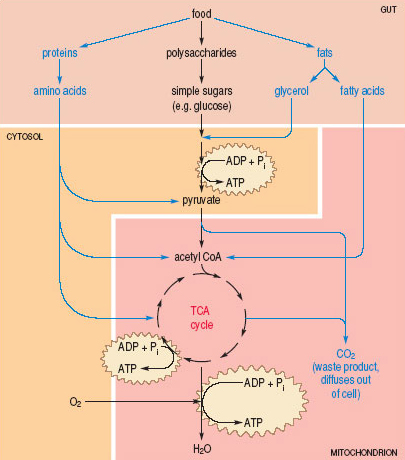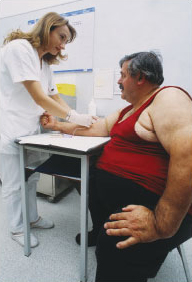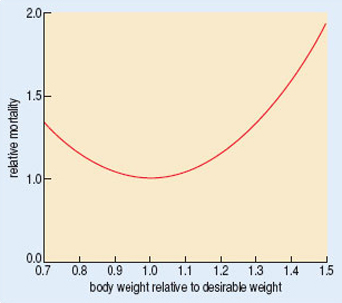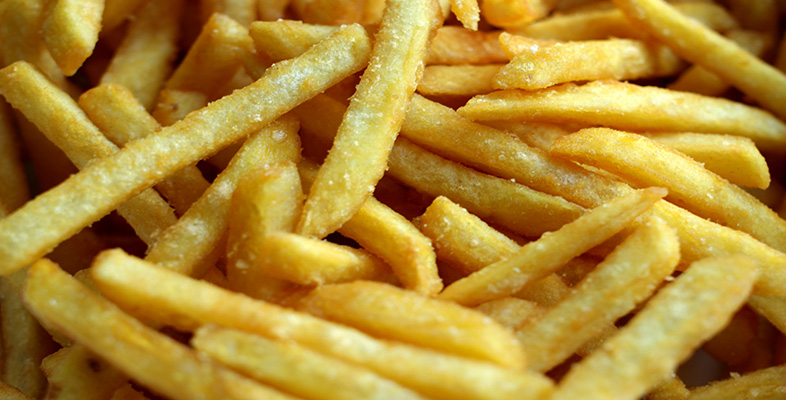1.1 Balanced energy intake
There is a need for a certain daily energy intake to allow metabolism to occur in the body. Metabolism means all the chemical reactions occurring in the body and there are two types of process involved: catabolism breaks down larger molecules into smaller ones often with energy release and anabolism is the building up of larger molecules from smaller precursors, often requiring energy. The body requires energy to power anabolic, mechanical (for example, muscle contraction and cellular movement), and transport (for example, the movement of substances across cell membranes) work within the body.
There is an ‘energy currency’ is used by the body in the same way that society uses money, known as adenosine triphosphate or ATP. ATP is represented in Figure 2 and is synthesized when certain nutrients are catabolized by the body. You do not need to remember the structure of ATP, but do note the three phosphate groups (triphosphate) and the adenosine group of the molecule – these give it the name of adenosine triphosphate.

Energy is released from ATP when it loses a phosphate group and becomes adenosine diphosphate or ADP. The energy released from this ATP catabolism can be used to power the energy-requiring processes in the body. So, using the money analogy, ATP is synthesized (or earned like money) and then catabolized (spent) where necessary. There is a difference in the analogy here in that the body is very efficient in how it uses ATP and wastes as little as possible, whereas we are not always as wise in the way we spend money! Proteins, carbohydrates and fats can all be catabolized to produce ATP. The metabolism of these macromolecules involves quite complicated biochemical pathways to ensure that the maximum amount of ATP is synthesized from each starting molecule. Figure 3 shows these pathways in a greatly simplified manner, although we do appreciate that they will not look simple if you have not previously studied biology! Note that ATP cannot be stored in the cell, so a constant supply of raw materials is necessary to maintain supplies.

Figure 3, above, shows a summary of the fates of proteins, carbohydrates and fats in metabolic pathways that result in the production of ATP. Food in the gut is broken down into its constituent amino acids, sugars, fatty acids and glycerol, and these building blocks are absorbed into cells. The first time ATP is made is in the cytosol, from sugars or glycerol. An important intermediate, called pyruvate, is made (amino acids can be converted into pyruvate too). Pyruvate is transported into the mitochondrion, where it is converted into acetyl CoA, which is a very important molecule. Fatty acids and amino acids can also be converted into acetyl CoA, Acetyl CoA enters a pathway called the TCA cycle, where more ATP is made. Waste carbon dioxide (CO2) is also produced at this stage (as it is from the pyruvate into acetyl CoA conversion earlier). Other products of the TCA cycle are further processed to make more ATP, and this step requires oxygen (O2) (the O2 we breathe in) and produces water (H2O) as a waste product.
Energy is released when certain nutrients are metabolized in the body and this energy is used to power other chemical reactions and cellular processes while some energy is lost as heat. Energy is measured in kilocalories (kcal) or kilojoules (kJ): one kcal is approximately 4.2 kJ and is defined as the amount of energy required to raise the temperature of 1 litre of water by 1 °C. Electrically igniting known quantities of the foodstuff in oxygen and then measuring the heat output gives an indication of the energy content of foods. The heat energy that is released by burning the food in oxygen is equivalent to the energy released in the body when the complex molecules in the food are metabolized completely. One of the reasons why metabolic pathways are so long and complex is that this allows a gradual release of the energy from the food rather than a sudden massive energy release, as occurs with burning. The energy yields of different nutrients are shown in Table 2.
| Nutrient type | Available energy/ | |
|---|---|---|
| kcal g−1 | kJ g−1 | |
| carbohydrate | 4 | 15–17 |
| fat | 9 | 37 |
| protein | 4 | 16 |
Activity 4
How much more energy in kJ per gram (kJ g−1) does fat yield than protein?
Answer
Fat yields 37 kJ g−1 of energy and protein yields 16 kJ g−1 of energy. So fat yields 37÷16 or 2.3 times more energy per gram than protein.
In other words, fats contain a more concentrated form of energy. It is therefore easy to exceed the DRVs for energy when eating a high-fat diet, and the excess is stored as fat in the body. Diets containing high proportions of fats have also been linked with disease (e.g. cancer of the colon and cardiovascular disease). If other energy sources in the diet are insufficient, first stored fat and then proteins are catabolized to provide energy and this will ultimately lead to muscle wasting (as muscles are made of protein).
The basal metabolic rate (BMR) is the amount of energy required to carry out the basic processes of life – the processes that continue as you sit quietly or lie asleep, such as breathing and the beating of your heart. BMR values are remarkably constant when related to lean body mass although BMR does change with the age and sex of the individual.
Activity 5
What evidence have you seen for this variation in BMR with age and sex?
Answer
Table 1 shows how EAR varies with these two factors.
Further energy expenditure is necessary to carry out everyday activities beyond the energy required for the BMR; this is called the total energy expenditure (TEE). TEE is directly related to the total amount of muscular activity but also to brain activity (the brain normally uses 20% of the available glucose and oxygen), age, environmental temperature (metabolism increases in cold climates to maintain body temperature), disease (metabolic rate increases by about 8% for every 0.5 °C increase in fever), pregnancy and lactation and energy intake (metabolic rate is decreased in prolonged under-nutrition). An individual maintains a stable weight when their total energy intake (TEI) balances their TEE.
Activity 6
Can you think what a diet containing insufficient energy-producing nutrients for an individual's TEE over a period of months may lead to?
Answer
If TEI is less than TEE over a period of months then the individual will lose body mass (weight). The extent of the weight loss depends on the difference between energy intake and expenditure and if this diet were maintained it would lead to malnutrition and an increased susceptibility to ill-health.
Activity 7
What would over-consumption of energy-producing nutrients result in?
Answer
Over-consumption would lead to weight gain (largely because of an increase in stored body fats) and eventually to obesity.
Obesity is greatly elevated body weight, above the desirable level, to an extent which is associated with serious increased risk to health. Average energy requirements for males and females at different ages were shown in Table 1 and Table 3 shows energy expended during different activities for a 70 kg person.
| Form of activity | Energy expended/kcal h−1 |
|---|---|
| lying still, awake | 77 |
| sitting at rest | 100 |
| typing rapidly | 140 |
| dressing or undressing | 150 |
| walking on level at 4.8 km h−1 | 200 |
| jogging at 9 km h−1 | 570 |
Our diet and our lifestyle are the main influences on our weight; although there is an additional genetic influence. A simple calculation called the body mass index (BMI) indicates whether an adult is a healthy weight for their height. To calculate your BMI divide your weight (in kg) by your height (in metres) squared.

There is not one perfect weight for every height but a range that allows for people's build. However, the BMI formula is not suitable for pregnant women, children and some medical conditions. Even with these caveats the BMI is not infallible but it can be a useful guide (Table 4).
| Body mass index | Classification |
|---|---|
| less than 18.5 | underweight |
| 18.5–25 | desirable or healthy range |
| 25–30 | overweight |
| 30–35 | obese (Class I) |
| 35–40 | obese (Class II) |
| over 40 | morbidly or severely obese (Class III) |
Activity 8
What is the BMI of a woman of 1.7 m who weighs 65 kg?
Answer

This value means that she would be in the healthy range for her body mass index.
Both overweight and obesity classifications are associated with increased incidence of serious conditions such as high blood pressure (hypertension), cardiovascular disease and type 2 diabetes (Figure 4; see Case Report 1), as well as conditions that are not life-threatening, but which do affect well-being, such as varicose veins and arthritis. On the gloomy side, both underweight and overweight individuals have an increased risk of premature death, as shown in Figure 5.


